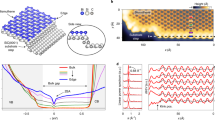Abstract
HgTe/CdTe and InAs/GaSb/AlSb superlattices both exhibit a topological insulator transition. In each case, there is an inversion of the s- and p-band ordering for layer thicknesses above a critical value. The resulting topological phase is a 2D bulk insulator at zero temperature, with edges that conduct massless carriers whose direction of motion is locked to their direction of spin. These 1D edge states exhibit essentially dissipationless transport over coherence lengths greater than one micron, with a quantized conductance of e2/h per edge. When a current passes, opposite spins are separated to the two sample edges, giving rise to the so-called quantum spin Hall effect. Effects such as these may be exploited in future low temperature spintronic devices. The edge states in HgTe/CdTe differ from those in InAs/GaSb/AlSb in several ways, due to the type II band alignment and weaker electron–hole hybridization of the III-V superlattice. The former exhibit a simple exponential decay over thousands of Angstroms, while the latter are more strongly confined to the edge, with an oscillating wave function whose period increases with the edge state momentum. In any calculation, the edge state dispersion and the nature of the wave-function depend strongly on the boundary conditions used. A k · p model is presented using standard boundary conditions for the wave function and its derivative, which yields spin polarized edge states with a finite amplitude at the sample edge. The interaction between states at opposite sample edges is also considered.
Similar content being viewed by others
References
B.A. Bernevig, T.L. Hughes, and S.-C. Zhang, Science 314, 1757 (2006).
C. Liu, T.L. Hughes, X.-L. Qi, K. Wang, and S.-C. Zhang, Phys. Rev. Lett. 100, 236601 (2008).
P.C. Klipstein, Phys. Rev. B 91, 035310 (2015); Erratum, Phys. Rev. B 93, 199905(E) (2016)
S.R. White and L.J. Sham, Phys. Rev. Lett. 47, 879 (1981).
M.F.H. Schuurmans and G.W. t’Hooft, Phys. Rev. B 31, 8041 (1985).
P.C. Klipstein, J. Phys. Condes. Matter 30, 275302 (2018).
P.C. Klipstein, J. Phys. Condes. Matter 28, 375801 (2016).
G. Tkachov and E.M. Hankiewicz, Phys. Status Solidi B 250, 215 (2013).
M. König, S. Wiedmann, C. Brüne, A. Roth, H. Buhmann, L.W. Molenkamp, X.-L. Qi, and S.-C. Zhang, Science 318, 766 (2007).
I. Knez, R.-R. Du, and G. Sullivan, Phys. Rev. Lett. 107, 136603 (2011).
L. Du, I. Knez, G. Sullivan, and R.R. Du, Phys. Rev. Lett. 114, 096802 (2015).
I. Knez, C.T. Rettner, S.-H. Yang, S.P. Parkin, L. Du, R.-R. Du, and G. Sullivan, Phys. Rev. Lett. 112, 026602 (2014).
C. Brüne, A. Roth, H. Buhmann, E.M. Hankiewicz, L.W. Molenkamp, J. Maciejko, X.-L. Qi, and S.-C. Zhang, Nature 8, 485 (2012).
E.Y. Ma, M. Reyes Calvo, J. Wang, B. Lian, M. Mühlbauer, C. Brüne, Y.-T. Cui, K. Lai, W. Kundhikanjana, Y. Yang, M. Baenninger, M. König, C. Ames, H. Buhmann, P. Leubner, L.W. Molenkamp, S.-C. Zhang, D. Goldhaber-Gordon, M.A. Kelly, and Z.-X. Shen, Nat. Commun. 6, 7252 (2015).
F. Nichele, H.J. Suominen, M. Kjaergaard, C.M. Marcus, E. Sajadi, J.A. Folk, F. Qu, A.J.A. Beukman, F.K. de Vries, J. van Veen, S. Nadj-Perge, L.P. Kouwenhoven, B.-M. Nguyen, A.A. Kiselev, W. Yi, M. Sokolich, M.J. Manfra, E.M. Spanton, and K.A. Moler, New J. Phys. 18, 083005 (2016).
P.C. Klipstein, stacks.iop.org/JPhysCM/28/375801/mmedia (2016)
Author information
Authors and Affiliations
Corresponding author
Rights and permissions
About this article
Cite this article
Klipstein, P. Topological Insulator Superlattices. J. Electron. Mater. 47, 5719–5724 (2018). https://doi.org/10.1007/s11664-018-6510-4
Received:
Accepted:
Published:
Issue Date:
DOI: https://doi.org/10.1007/s11664-018-6510-4




